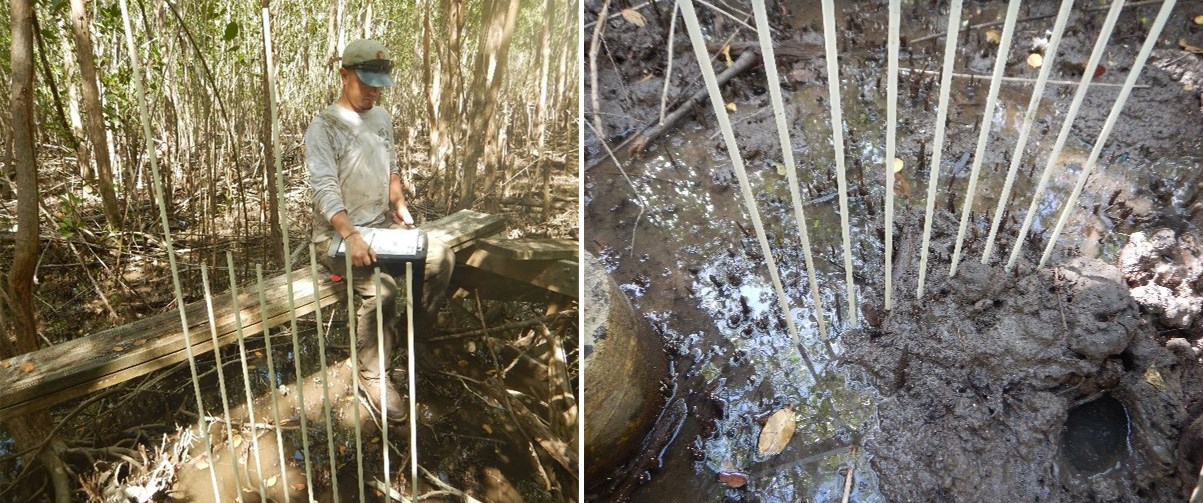Last updated: January 10, 2025
Article
Soil Surface Elevation on the Decline Again at SARI

NPS photos / SFCN staff
Overview
Mangrove wetlands provide flood control, storm protection, shore stabilization, capture soil runoff, carbon storage, and habitat for fish and wildlife communities. The soil elevation in mangrove forests affects tidal inundation period and frequency, sedimentation, erosion, and the shrink and swell of soil materials, which all impact mangrove seedling growth, composition, and survival. If the rate of relative sea level rise is greater than the rate at which mangrove soil elevation increases, then as the trees die off there is no mangrove growth to replace them. These areas will eventually convert to shallow open water marine habitats and the mangrove forest will move inland. Understanding this rate of change is critical to predicting the long-term ability of mangrove forests to regenerate. The National Park Service (NPS) South Florida / Caribbean (SFCN) Inventory and Monitoring (I&M) Network established a long-term soil surface elevation monitoring program in Biscayne National Park, Salt River Bay National Historical Park and Ecological Preserve, and Virgin Islands National Park.
Methods
Three benchmarks are established at each monitoring location, and each benchmark uses a removable SET measuring device to determine surface elevation. The SET instrument is temporarily attached to a permanent benchmark. The distance to the sediment surface is measured with fiberglass pins lowered to the surface. Marker horizons are layers of feldspar placed on the soil surface. They help determine what is affecting soil elevation change measured by the SET. Factors affecting the change include sediment deposition or erosion, root growth, decomposition, shrink and swell, and compaction.
Findings
Recent soil surface elevation monitoring in the mangroves at Salt River Bay National Historical Park (SARI) revealed that after seven years of increase, levels are once again on the decline. This data was collected from December 2023 to May 2024, according to the Coastal Geomorphology: Monitoring Mangrove Soil Surface Elevation Tables in Salt River Bay NHP 2024 Data Summary Report from the South Florida/Caribbean Inventory and Monitoring Network. Data from 2016 to the summer of 2023 showed the soil elevation was returning to original levels.
The report explains the decrease could be due to the Mon Bijou levee system further upstream on the Salt River. Mon Bijou’s management of the river's flow could be inadvertently delivering or withholding material deposits to the park's data collection site. Extreme weather could also be a factor in the decline. In 2017, the site was hit by Hurricane Irma and Hurricane Maria. Trees at the site have shown signs of severe windstorm damage since the hurricanes came ashore. Since 2019, the report suggests the soil surface elevation appears to be fluctuating just below the original soil elevation.
It should be noted that previous attempts to establish accretion plots in the park have been made, but the feldspar washes away. Without these marker horizons, surface accretion can't be determined. Continued monitoring is needed to fully understand the relationship between the soil elevation pattern and other factors such as hydrology, storm patterns, and biological inputs.
Full Report
Link to report on NPS Integrated Resource Management Applications (IRMA) Portal

